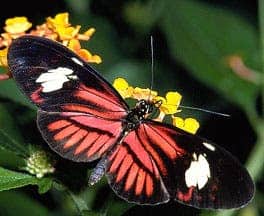
In the most comprehensive and thorough survey of its kind, an international team of scientists sampled, sorted and cataloged every arthropod species they could find in patches of Panama’s San Lorenzo rainforest. During their survey of areas summing up to roughly three acres, the scientists estimated that a 6,000 hectare forest houses 25,000 arthropod species, 60% to 70% of which are likely to be previously unknown.
Almost 100 scientists were involved in the IBISCA-Panama project, which lasted almost a decade and whose findings were only recently published.
“This is the first time that diversity of all types of arthropods has been quantified from a tropical rainforest,” says ecologist Tomas Roslin of the University of Helsinki, an author of the new paper.
The scientists used 14 survey techniques to collect and categorize the various insects and spiders from 20-by-20 square meter plots in San Lorenzo Forest, this includes picking beetles from rotten wood, climbing trees and lifting helium balloons to reach the peaks of the rainforest trees, and pluck lingering insects off the branches. This operation continued for three seasons, time in which the researchers collected 129,494 arthropods, compared to mere thousands previous surveys achieved. The next 8 years were spent by the researchers identifying and cataloging the arthropod species. It’s worth mentioning that the arthropod family houses the most multicellular species. Practically, for every mammal species, there are 300 arthropod species that live in the rainforest alone.
The rainforest is bustling with life
Still, considering the huge number of insects collected, one can imagine that not every species was fully described, documented or even given a name, instead most of them were sorted by their basic characteristics, in order to lessen the load considerably, while not affecting the accuracy of the count. Some 0.48 hectares in combined surface were directly studied, where 6144 arthropod species were identified. By scaling up diversity values and extrapolating their known data, the researchers estimated the rainforest reserve harbors in excess of 25,000 arthropod species.
“If we are interested in conserving the diversity of life on Earth, we should start thinking about how best to conserve arthropods,” . “What surprised us the most was that more than half of all species could be found in a single hectare of the forest”, said Basset. “This is good news, as it means that to determine the species diversity of a tropical rainforest, we need not sample gigantic areas: a total of one hectare may suffice to get an idea of regional arthropod richness – provided that this total includes widely spaced plots representative of variation within the forest,” said Roslin.
One of the most interesting findings this massive research has to offer, however, lies in the byline. The scientists found a link between the number of arthropod species and the richness of plant diversity in the area.
“Another exciting finding was that the diversity of both herbivorous and non-herbivorous arthropods could be accurately predicted from the diversity of plants”, says Basset. “By focusing conservation efforts on floristically diverse sites, we may save a large fraction of arthropods under the same umbrella. Further, this strengthens past ideas that we should really be basing estimates of global species richness on the number of plant species,” stresses Roslin.
“While we have assigned immense resources to mapping our genes, resolving sub-atomic structures and searching for extra-terrestrial life, we have invested much less in exploring with whom we share the Earth. Why such research should be run on a shoe string budget just escapes me,” reflects Basset.
The findings were published in the journal Science.
via Wired
Was this helpful?



